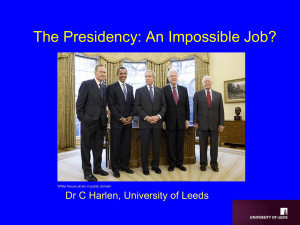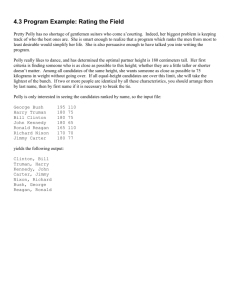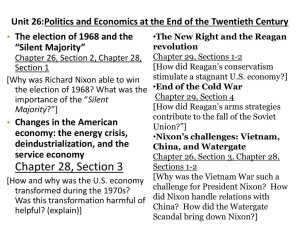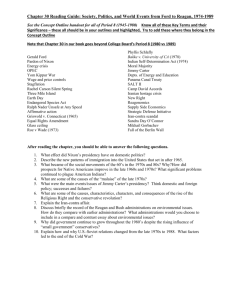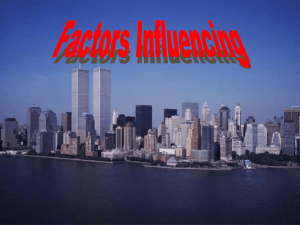Protest Movements Protests movements of the period from 1960
advertisement
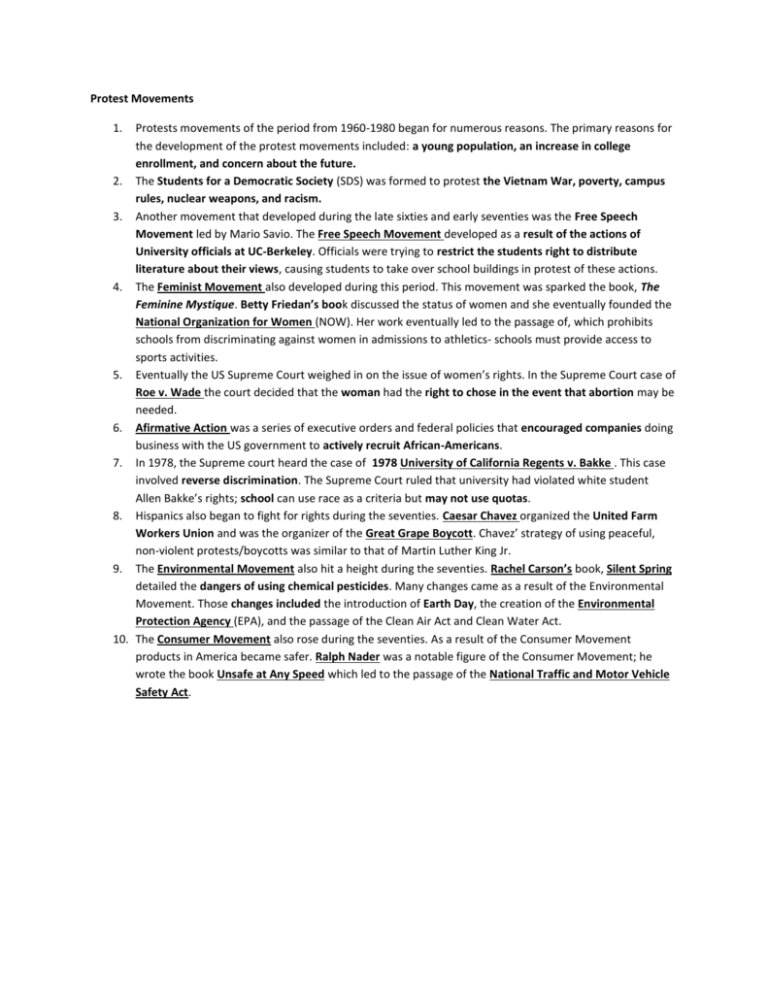
Protest Movements 1. Protests movements of the period from 1960-1980 began for numerous reasons. The primary reasons for the development of the protest movements included: a young population, an increase in college enrollment, and concern about the future. 2. The Students for a Democratic Society (SDS) was formed to protest the Vietnam War, poverty, campus rules, nuclear weapons, and racism. 3. Another movement that developed during the late sixties and early seventies was the Free Speech Movement led by Mario Savio. The Free Speech Movement developed as a result of the actions of University officials at UC-Berkeley. Officials were trying to restrict the students right to distribute literature about their views, causing students to take over school buildings in protest of these actions. 4. The Feminist Movement also developed during this period. This movement was sparked the book, The Feminine Mystique. Betty Friedan’s book discussed the status of women and she eventually founded the National Organization for Women (NOW). Her work eventually led to the passage of, which prohibits schools from discriminating against women in admissions to athletics- schools must provide access to sports activities. 5. Eventually the US Supreme Court weighed in on the issue of women’s rights. In the Supreme Court case of Roe v. Wade the court decided that the woman had the right to chose in the event that abortion may be needed. 6. Afirmative Action was a series of executive orders and federal policies that encouraged companies doing business with the US government to actively recruit African-Americans. 7. In 1978, the Supreme court heard the case of 1978 University of California Regents v. Bakke . This case involved reverse discrimination. The Supreme Court ruled that university had violated white student Allen Bakke’s rights; school can use race as a criteria but may not use quotas. 8. Hispanics also began to fight for rights during the seventies. Caesar Chavez organized the United Farm Workers Union and was the organizer of the Great Grape Boycott. Chavez’ strategy of using peaceful, non-violent protests/boycotts was similar to that of Martin Luther King Jr. 9. The Environmental Movement also hit a height during the seventies. Rachel Carson’s book, Silent Spring detailed the dangers of using chemical pesticides. Many changes came as a result of the Environmental Movement. Those changes included the introduction of Earth Day, the creation of the Environmental Protection Agency (EPA), and the passage of the Clean Air Act and Clean Water Act. 10. The Consumer Movement also rose during the seventies. As a result of the Consumer Movement products in America became safer. Ralph Nader was a notable figure of the Consumer Movement; he wrote the book Unsafe at Any Speed which led to the passage of the National Traffic and Motor Vehicle Safety Act. Nixon Presidency 11. Richard Nixon was elected president in 1968. Nixon’s New Southern Strategy allowed him to ensure electoral success in a traditionally Democratic region. 12. President Nixon’s legislative agenda was known as New Federalism which called for dismantling federal government programs and giving control to state and local governments. 13. During the Cold War, President Nixon’s policy was known as détente. The policy of détente called for the easing of tensions between the U.S. and Soviet Union 14. In 1972, President Nixon became the first US President to visit the country of China. He hoped to eventually establish “normal “relations with China. 15. President Nixon signed the Strategic Arms Limitation Treaty (SALT) promising to reduce America’s stockpile of nuclear weapons and limit development of nuclear weapons. 16. President Nixon is possibly most remembered for the Watergate Scandal. During the Watergate Scandal, Nixon tried to cover up his misdeeds during the Election of 1972. President Nixon refused to turn over Whitehouse tapes, claiming the he had Executive Privilege (the right of a president to keep conversations and meetings private). Eventually the scandal made it to the hearing rooms of the US Supreme Court. In the case, United states v. Nixon the court ordered President Nixon to turn over Whitehouse tapes to the prosecutor. As a result of the actions of Nixon and the conversations heard on the tapes, Congress voted to impeach Nixon. But prior to the House vote, President Nixon became the first and only president in US history to resign. Ford Presidency 17. Gerald Ford became president when Richard Nixon resigned. In its early years, the Ford presidency was consumed by the Watergate Scandal. As a result of spending so much time dealing with the scandal of Nixon, President Ford decided to pardon former President Nixon. Ford’s popularity with the American public went down 18. During this period America faced many economic problems. Stagflation (mix of inflation and recession) was a major problem during the seventies. The mixture of inflation and economic recession led to terrible economic times in the 1970s. 19. OPEC (Oil Producing & Exporting Countries) often used oil as a political weapon. During the 1970s, OPEC placed an oil embargo on the U.S. As a result of the embargo imposed by OPEC, the US experienced its first oil shortage since World War II. 20. Ford’s Administration started the WIN (Whip Inflation Now) Program. WIN was an ineffective attempt at dealing with stagflation 21. During the Ford Presidency, the Helsinki Accords were signed. The Helsinki Accords recognized the borders of Europe, as they had been at the end of World War II. Carter Presidency 22. Jimmy Carter won the election of 1976. Upon entering office, President Carter faced many challenges. America was facing an Oil & Energy Crisis as a result of the OPEC oil embargo. The Oil & Energy Crisis had a negative impact on the American economy and President Carter lost popularity as a result of his mishandling of the crisis. In his Malaise Speech He scolded the American public which caused the public to turn on him. His economic policies caused a devastating combination of increasing unemployment and increasing inflation. 23. President Carter also faced issues on the Foreign Policy stage. He helped the leaders of Egypt and Israel reach a peace agreement. The Camp David Accords was the peace agreement the President Carter negotiated between Egyptian leader, Saddat, and Israeli leader, Begin. 24. This gained President Carter some accolades, but in 1979 Iranians stormed the US Embassy in Tehran and to 52 Americans hostage. This incident became known as the Iran Hostage Crisis. The Iran Hostage Crisis lasted for 444 days and although President Carter attempted a secret military rescue, the hostages were still being held in November of 1980, when the Presidential Election was taking place. 25. As a result of the failed attempt to solve the Iran Hostage Crisis, the poor economy, and the Oil and Energy Crisis, President Carter’s approval rating was low and so were the spirits of the American public. Reagan Presidency 26. Americans spirits enter the 1980s were low due to the problems America endured during the Carter Presidency. These problems included the Oil & Energy Crisis, wars in the Middle East, and the Iran Hostage Crisis. 27. As a result of the low public support for President Carter, Ronald Reagan won the Election of 1980. 28. Reagan’s conservative support came from a wing of the Republican Party known as the New Right. The New Right advocated reversals in liberal policies, endorsed school prayer, fought for deregulation, supported lower taxes, advocated for a strong military, and smaller government. The New Right movement grew as a result of televangelism and televangelist/leader Jerry Fallwell . 29. President Reagan’s primary concern upon entering office was improving the American economy. Reagan’s plan to improve the American economy became known as Reaganomics. Reaganomics used the theory of supply-side economics to build up the economy. Supply-side economics is based on the belief that tax cuts and business incentives will stimulate economic growth. Through the use of supply-side economics, the budget deficit will decrease and may eventually be eliminated. Reagan Presidency (continued) 30. President Reagan often referred to the Soviet Union as the “Evil Empire”. The defend America against Soviet missiles President Reagan initiated the creation of a program known as the Strategic Defense Initiative (SDI or “Star Wars”). President Reagan thought that SDI would ease the growing pressure to ____________. 31. As President Reagan was developing SDI, Mikhail Gorbachev rose to power in the Soviet Union. The emergence of Gorbachev would eventually allow Reagan to be re-elected and would lead to negations between President Reagan and Soviet Leader Gorbachev. 32. President Reagan nominated Sandra Day O’Connor to be a justice on the Supreme Court. After Senate confirmation, Sandra Day O’Connor became the first woman to be appointed to the Supreme Court. 33. Reagan was up for re-election in 1984. The candidate involved in the Election of 1984 included: Ronald Reagan/George HW Bush (Republican ticket), Walter Mondale/Geraldine Ferraro-first female to run for VP (Democratic ticket). Reagan & Bush emerged victorious. 34. In 1985, President Reagan backed the anti-communist rebels (known as Contras) in Nicaragua. This would lead to a scandal known as the Iran-Contra Affair. Vice Admiral John Poindexter and Lieutenant Colonel Oliver North carried out the plan. In 1986, after Congress began to investigate, President Reagan admitted to authorizing the Iran arms sales but denied knowledge of the movement of funds to support the affair. 35. In 1986, President Reagan faced a tragedy in the space program. The Challenger Disaster took place. In this incident the Space Shuttle Challenger blew up killing all astronauts on board. President Reagan handled this incident remarkably and gained support as a result. 36. Most immigrants to American in the period from 1980-2000 were Hispanics or Asians. George HW Bush Presidency 37. George H.W. Bush was elected president in 1988. Because of the faltering economic situation, Bush made the following statement regarding his economic plan “READ MY LIPS, NO NEW TAXES”. 38. As Bush entered office, the Soviet Union (USSR) was undergoing major change. Mikhail Gorbachev introduced the idea of Glasnost (“opening”) which lifted media censorship. Gorbachev did not stop with Glasnost, he also unveiled perestroika, a program which had the goal of restructuring the Soviet economy. 39. During the Bush Era, Communist leaders in China tried to crush the idea of democracy in their country. This attitude led to the Tiananmen Square Massacre . During the Tiananmen Square Massacre, Chinese officials sent in armored tanks to stop the protests of pro-democratic Chinese students. After this incident, President Bush stated that the United States would stay “engaged” in China. 40. In 1990, Saddam Hussein leader of Iraq, invaded the neighboring country of Kuwait.. After the invasion, President Bush declared that Saddam Hussein’s aggression “would not stand”. In 1991, President Bush ordered and attack on targets in both Iraq and Kuwait. After other nations joined the American forces in the fight, The U.S. launched Operation Desert Storm which led to the eventual defeat of Iraq. By late February or early March 1991, the goal of the Persian Gulf War had been achieved. The primary goal that US forces had during the Persian Gulf War was the liberate Kuwait (Kick Iraq out of Kuwait). This goal was achieved, which brought an end to the Persian Gulf War 41. The Texas v. Johnson Court case took place in 1989. In the Supreme Court Case, Texas v. Johnson, the court ruled that flag burning used as political protest was covered under the first amendment free speech. Clinton Presidency 42. In 1992 Bill Clinton (Democrat) defeated George H.W. Bush (Republican) & H. Ross Perot (Reform) and became President of the US. Bill Clinton was the first baby boomer to become president .Some of Clinton’s primary goals upon entering office included deficit reduction, health care reform, welfare reform, and fighting terrorism (Any acts made by groups to achieve political goals). 43. President Clinton did have success in bringing some peace to the Middle East. In 1993, the Israeli’s and Palestinians agreed to the Oslo Accords. 44. President Clinton also had to deal with issues in the African nation of Somalia. President Clinton tried to help the UN in its effort to end the civil war in Somalia. As a result, a number of American forces died (Black Hawk Down). As a result, Clinton chose to withdraw American forces from Somalia. 45. In 1993, President Clinton proposed budget to Congress that raised taxes. Republicans in Congress refused to sign. Eventually, compromise was reached, which included reduced budget deficits By 1997, America would achieve it’s first balanced budget in history. 46. In 1994, Republican Newt Gingrich (Ga.) introduced the “Contract with America” a program that proposed 10 changes which included, lower taxes, welfare reform, anticrime laws, balanced budget etc 47. During the Clinton Presidency, the Family Medical Leave Act was passed. The Family Medical Leave Act gave workers 12 weeks per year of unpaid family leave for birth of child, adoption, illness of a family member. 48. In 1996, Congress passed the Welfare Reform Act, a law which limited people to no more than two consecutive years on welfare & required them to work to get welfare benefits. 49. Under President Clinton the Brady Bill was signed into law. The Brady Bill imposed a waiting period before people could buy handguns, background check required for gun dealers to sale guns to individuals. This was viewed by many as a form of gun control, thus violating our 2nd Amendment rights. 50. In 1996, President Clinton also had to deal with problems in Bosnia-Herzegovina (formerly Yugoslavia). After much bloodshed, President Clinton urged the areas of Bosnia and Serbia to sit down and discuss their problems. The discussion resulted in the signing of the Dayton Accords which was aimed at ending the fighting. 51. In 1999, President Clinton urged N.A.T,O, to act against Serbia. Clinton’s goal was stop the Serb army’s attempt to force ethnic cleansing of the Serbian region of Bosnia. N.A.T.O. conducted a bombing campaign which succeeded in achieving Clinton’s goals. 52. To encourage trade with Canada and Mexico, President Clinton signed the North American Free Trade Agreement (NAFTA). NAFTA established a free-trade zone that included the U.S, Canada, and Mexico. Clinton believed that NAFTA would increase trade which would help the economy. But, critics of NAFTA say that the agreement cost American jobs because work will be outsourced to Mexico. 53. In 1999, President Clinton became only the second US president to be impeached. He was impeached because of his actions in two scandals, the Whitewater Scandal and the Monica Lewinski scandal. Election of 2000 54. In the Election of 2000, George W. Bush (Republican) faced off against Al Gore (Democrat). Al Gore won the popular vote, but no candidate achieved a majority of electoral votes. Both candidates needed the 25 electoral votes from Florida, As a result of this, Al Gore asked for a hand recount (in strong Democratic counties only) because the machine recount had Bush in the lead. As a result of this fight over Florida’s electoral votes, the case of Bush v. Gore was heard in the U.S. Supreme Court. The decision in the Bush v. Gore case stated that all hand recounts were to cease. As a result of the Supreme Court’s ruling, George W. Bush was declared the winner. George W. Bush Presidency 55. Entering office President Bush’s priority was to lowering taxes. Congress would eventually pass $1.35 trillion in tax cuts. 56. During the early years of the Bush Presidency, Congress passed the No Child Left Behind Act (NCLB). This law proposed standardized testing in reading and math grades 3-8 in all states; all groups of students must show improvement. The goal of the No Child Left Behind Act (NCLB) was to improve student achievement. 57. Critics of NCLB say that the law places too much emphasis on testing and scores and penalizes schools who otherwise meet their goals. 58. President Bush favored developing missile defense systems (similar to the idea which Reagan developed). These missile defense systems would be able to shoot down enemy nuclear missiles directed toward the US. 59. The most significant events in President Bush tenure as president were the terrorist attacks of 9/11/2001.. On September 11, 2001, terrorists crashed passenger planes into the World Trade Center and Pentagon. Osama Bin Laden and his terrorist group, Al Qaeda were behind the September 11th Attacks. 60. As a result of the 9/11 Attacks, President Bush launched the War on Terrorism. The first move in the War on Terror was to invade Afghanistan. America’s goal upon entering Afghanistan was to hunt down Osama Bin Laden, kill or capture him, and remove the terrorist-supporting Taliban government. 61. As a part of the War on Terror, President Bush authorized the created of the Department of Homeland Security, to help protect the US from future terrorist attacks. 62. In 2001, Congress passed the Patriot Act. The Patriot Act permitted secret government searches of suspected terrorists and supporters with one nationwide search warrant; easier to wiretap and track internet communications. 63. Critics of the Patriot Act say that it violates 4th Amendment rights, which protect Americans against unreasonable searches and seizures.
